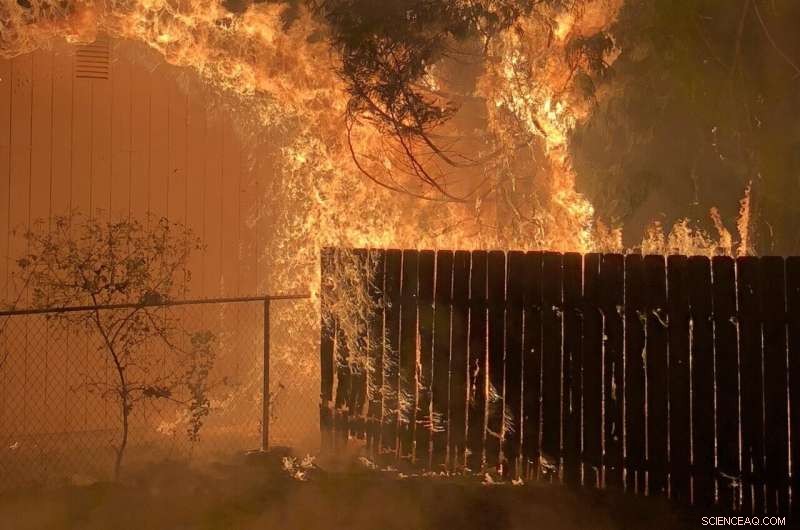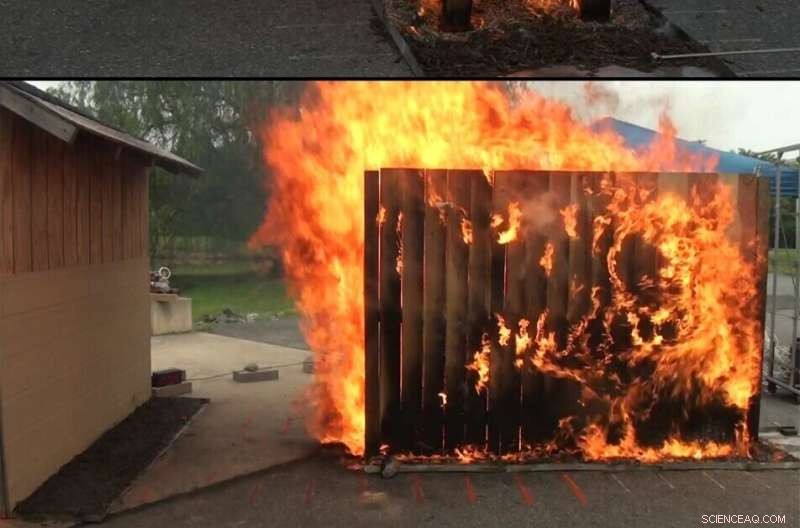
Staket och kompost är vanliga bidragsgivare till spridningen av bränder i samhällen med vildmark-urban interface (WUI). Det här fotot föreställer lågor som spred sig från ett brinnande staket till en byggnad cirka 1,8 meter (6 fot) bort under lägerbranden 2018. Kredit:CAL FIRE
När man bygger staket och anlägger sina fastigheter, bör husägare hålla brandsäkerheten högst upp i sinnet, särskilt om de bor i en region som är utsatt för skogsbrand, enligt en ny studie.
I nästan 200 brandexperiment brände forskare vid National Institute of Standards and Technology (NIST) bostadsstängsel och mulchbäddar för att undersöka vilken roll de spelar för att sprida eld. De fann att brandrisken i allmänhet var oproportionerligt högre när brännbara föremål brann ihop. Lågor rusade längs mulch som kantade basen av staket, och infernos svalde snabbt upp par stängsel när de brann i nära anslutning till varandra. Däremot brändes fristående staket fria från kompost eller skräp i en mycket långsammare takt. Baserat på sina resultat rekommenderade författarna till rapporten att husägare inte placerar två staket rygg mot rygg, håller andra brännbara ytor långt ifrån varandra och vidtar viktiga andra åtgärder.
Skogsbränder kan spridas snabbt genom och potentiellt överväldiga samhällen som gränsar till vildmarken – det så kallade gränssnittet mellan vildmark och städer (WUI). Studier efter skogsbränder, inklusive NIST:s studie av lägerelden 2018, har utpekat staket och kompost som bovar i spridningen av eld.
"Staket som fattade eld var ofta helt borta. Om man tittade noga kunde man se några spikar och skruvar kvar. De vi såg delvis brända fick stå kvar eftersom de försvarades av någon", säger rapportens medförfattare Alexander Maranghides, som leder NIST:s Camp Fire-studie. "Dessa saker släpper inte ut sig själva."
Staket och kompost kan fungera som broar för lågor för att nå byggnader och som avfyringsramper för luftburna glöder för att antända bränder långt borta, men brandkoder i USA tar inte upp hur de ska installeras och underhållas, och det finns lite vägledning för att hjälpa husägare.
För att hjälpa till att bygga en teknisk grund för utvecklingen av riktlinjer i framtiden, försökte författarna till den nya rapporten studera staket- och mulchbränder under förhållanden som ligger närmare det verkliga livet än vad som använts i tidigare studier.
Forskargruppen brände staket, mulchbäddar och kombinationer av båda utomhus, och antände materialen flera meter medvind från en vindmaskin som användes för att simulera verkliga brandspridningsförhållanden. Medvinden från elden satte laget upp ett skjul eller mulchbädd som mål.
Genom 187 experiment brände de bränsle enbart och i kombination, inklusive staket av flera vanliga konstruktioner gjorda av trä, vinyl eller trä-plastkompositer och mulchbäddar sammansatta av strimlat lövträ, tallbarkklumpar, tallhalm eller gummi.
Forskarna fångade bilder av bränderna för att mäta hastigheten och mönstret för flamspridningen och för att registrera hur ofta glöd antände målskjulet. They also conducted research in the lab to measure how quickly samples of fence raw materials released heat.
Taking all the data together, the authors categorized the relative fire threat level for the various test conditions.
"In the highest hazard category, the fences and mulch are going to carry the fire along toward your house in a matter of a few minutes, not hours," said NIST physicist Kathryn Butler, co-lead author of the report.

An experiment wherein NIST researchers burned two privacy fences separated by 46 centimeters (18 inches), sitting on top of mulch, demonstrates the danger of placing fences back to back. In less than four minutes after ignition, the fences were entirely engulfed in flames, which extended several feet beyond the fences. Credit:NIST
The most dangerous fires observed were those that had multiple sources of fuel burning at the same time. In the tests where mulch lined the bottom of a fence, fire tended to swiftly advance across the beds of fine combustibles, which served as rich sources of embers and allowed flames to quickly ignite the fence along its entire length.
The researchers learned that the fires could get much worse as well.
When two fences made of combustible materials were placed back to back—mimicking the scenario where two neighbors each put up a fence along their property lines—the most intense flames of the entire project erupted. After the fire was established, long-reaching flames quickly shot up, completely engulfing fence panels 2.4 meters (8 feet) long and 1.8 meters (6 feet) tall in as little as four minutes. Embers sparked fires on the target in almost every one of these tests.
"It's very well known that when you confine a fire on the sides, it's bad news. Keeping those hot gases between the fences with surfaces radiating intense heat to each other leads to explosive fire behavior," Butler said.
When fence panels burned alone, it was a different story. Flames slowly chewed away at the fences and did not spread very far during these experiments, with some progressing less than a meter (3.3 feet) in an hour. Although these fires burning slowly on a sole fuel source were less hazardous and more manageable, high winds that may accompany a wildfire could blow debris toward the fence, adding fuel to the fire.
Butler, NIST mechanical engineer Erik Johnsson and the rest of the authors crafted seven recommendations for homeowners living in WUI zones based on their analysis. The first recommendation is to avoid doubling up on fences completely, as the study found that fences as far apart as 91 centimeters (3 feet) still produced large flames. The second says that combustible fences should be placed where they will not interfere with exit routes.
Other recommendations advise keeping combustibles as far away from each other as possible, even between property lines, and clearing yards—and especially the space near or between fences—of debris, such as leaves or fallen branches.
The report also indicates that homeowners should replace combustible landscape features with those consisting of noncombustible material such as stone, steel or cement, when possible.
Because of the ever-present danger of embers during wildfires—even when there is a large distance between a structure and the fire—the researchers also urge homeowners to enhance their homes to resist ember ignition through a process called hardening. The detailed steps for hardening are described in a separate NIST report on mitigating wildfires.
The team members intend to keep pushing forward to cover new ground in wildfire research.
With additional experiments, they plan to offer additional insights on risk mitigation and eventually lay a groundwork for new guidance, standards and fire codes that could curb the real wildfire hazards that endanger life and property in the U.S.
The research was published as NIST Technical Note 2228 . + Utforska vidare